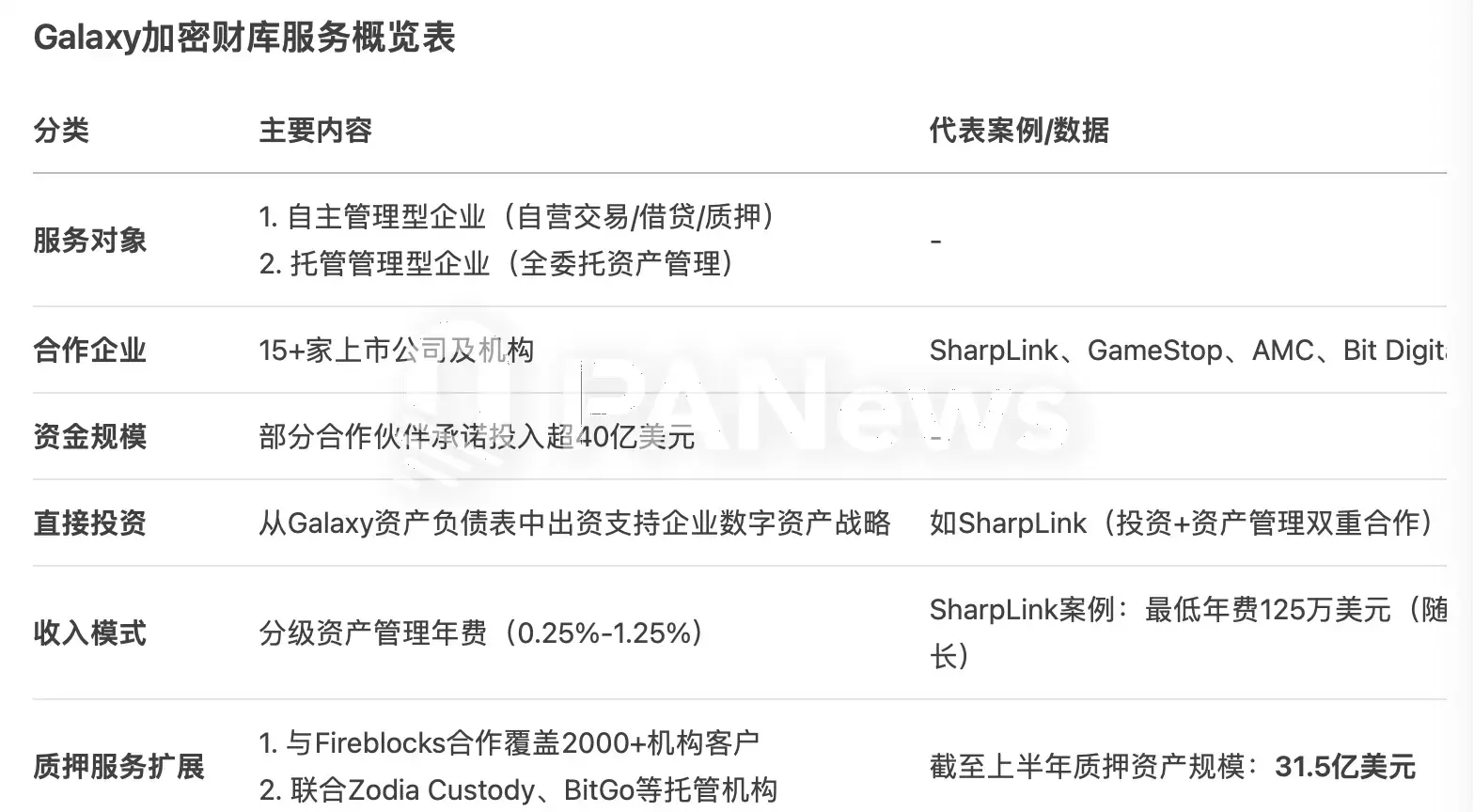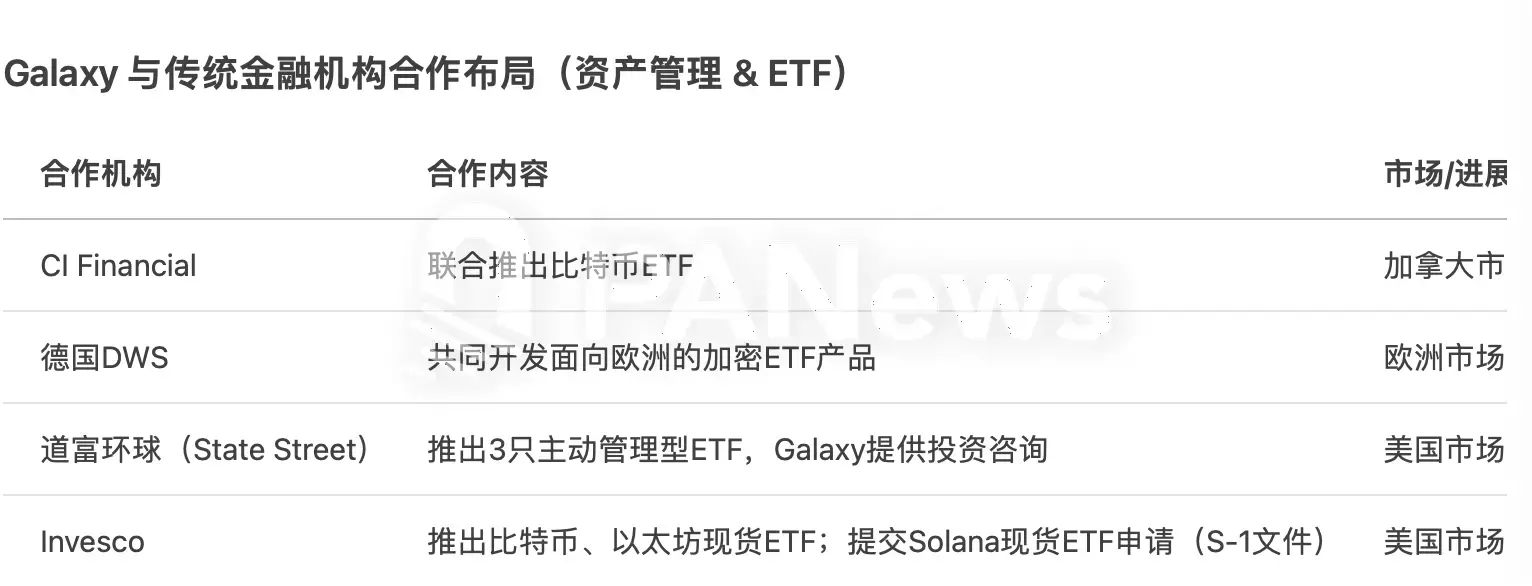The Behind-the-Scenes Driver of Crypto Treasuries: The Business Strategy Behind Galaxy Digital's Move to U.S. Stocks
Original author: Nancy, PANews
Currently, various cryptocurrencies and stocks are competing to rally, taking turns to showcase dramatic surges, vying for market attention. Unlike the overt competition among front-stage players, Galaxy Digital is one of the behind-the-scenes operators in this treasury narrative. In fact, from asset management services to infrastructure construction, from direct investment to structured support, Galaxy is accelerating its compliance transformation and diversification strategy after entering the traditional capital market.
Launching Two Types of Customized Services, Galaxy Becomes the Behind-the-Scenes Driver of Crypto Treasuries
Currently, more and more companies are allocating part of their assets to mainstream cryptocurrencies such as Bitcoin and Ethereum for asset reserves, inflation hedging, and even generating financial returns.
Despite market concerns about the leverage levels and debt repayment capabilities of some crypto financial companies, Alex Thorn, head of research at Galaxy Digital, recently pointed out that these concerns are significantly exaggerated. He stated, "In terms of overall scale, the debt volume of these companies is relatively limited, and most of the debts mature more than two years in the future."
Behind Galaxy's confidence in the evolutionary trend of crypto finance, it is precisely the behind-the-scenes driver of this reserve boom. Whether it's newcomers making their first crypto asset allocation or mature enterprises optimizing their existing allocations, Galaxy is providing comprehensive support from trading, investment, structural design to technical deployment for major institutions to initiate and expand their crypto treasury operations.
It is reported that Galaxy mainly provides services to two types of corporate treasury participants: (1) Self-managed enterprises: can use Galaxy's institutional-grade technology platform to conduct trading, lending, and staking operations on their own; (2) Enterprises seeking custody management: can partner with Galaxy Asset Management to obtain comprehensive management strategies and infrastructure support.
According to official disclosures, in the past few weeks, Galaxy has become the preferred partner for the crypto treasury projects of over 15 leading enterprises, such as SharpLink, BitMine, GameSquare, GameStop, AMC, Bit Digital, K Wave Media, TLGY Acquisition Corp, and ReserveOne, providing them with infrastructure, professional services, and end-to-end support. Among them, some partners have committed over $4 billion in funds to crypto assets. In some cases, Galaxy has also participated as a direct investor from the company's balance sheet to support these enterprises' digital asset strategies.

Customized services for crypto treasuries are also becoming one of Galaxy's important revenue sources. Taking SharpLink Gaming as an example, Galaxy not only invested in the company but also signed an asset management agreement with it to manage its Ethereum treasury. According to U.S. SEC documents, SharpLink is required to pay Galaxy and ParaFi Capital a tiered asset management fee ranging from 0.25% to 1.25% annually, with a minimum of $1.25 million per year. As SharpLink continues to expand its ETH treasury scale, Galaxy will also receive continuous and substantial returns.
More notably, as institutional staking demand increases, Galaxy is also optimizing related services to achieve more returns. For example, not long ago, Galaxy announced a partnership with Fireblocks to introduce its staking services directly to Fireblocks' platform's over 2,000 institutional clients. In addition, Galaxy has partnered with institutional-grade custodians such as Zodia Custody, BitGo, and Liquid Collective this year to further expand its staking business. According to official statements, as of the first half of this year, Galaxy's staking assets reached $3.15 billion.
First-Quarter Losses Wipe Out Annual Profits, Accelerating Diversification Strategy After Listing
"Whether institutions or innovators, they all need a trusted partner to meet the needs of a globally connected, digital financial system. Galaxy aims to be the preferred one-stop platform for institutions seeking financial services in the crypto economy," said Galaxy founder Mike Novogratz in the prospectus.
In fact, Galaxy is trying to respond to the highly volatile and uncertain crypto market environment with a more diversified structural strategy. Currently, Galaxy's business structure mainly revolves around three core sectors: global markets (covering trading and investment banking), asset management, and digital infrastructure solutions (including mining, staking protocol support, and self-custody technology). Among them, trading business is the cornerstone of Galaxy's revenue. According to the prospectus, Galaxy's total revenue in 2024 approached $42.6 billion, with about 99% coming from digital asset trading business. However, this single structure exposes significant risks during market downturns.

This year, as the trading activity of non-Bitcoin crypto assets continues to decline, Galaxy has been the first to bear the brunt. By the first quarter, Galaxy reported a net loss of $295 million, mainly due to the decline in crypto asset prices and the shutdown of the Helios data center mining business. The quarterly loss almost wiped out the entire year's net income of nearly $350 million in 2024. In addition, by the end of the first quarter, Galaxy's assets under management shrank significantly by 29% compared to the previous quarter, dropping to $7 billion, further demonstrating the pressure of crypto market volatility on its asset management business.
Despite short-term performance pressure, Galaxy still has ample ammunition. By the end of the first quarter of 2025, the institution held $1.1 billion in cash and stablecoins, as well as $1.9 billion in equity reserves.
Apart from the crypto treasury business, Galaxy is currently expanding other ecosystem layouts to promote revenue diversification and reduce reliance on the single point of trading business.
For example, in the asset management business, Galaxy is expanding its layout of crypto ETFs through in-depth cooperation with multiple global financial institutions. As early as in the Canadian market, Galaxy partnered with CI Financial to launch a Bitcoin ETF, facilitating the rapid landing of compliant crypto investment products in North America; in Europe, Galaxy reached a strategic cooperation with German asset management giant DWS to jointly develop crypto asset ETF products for the European market; in the U.S. market, Galaxy even partnered with the third-largest ETF issuer, State Street Global Advisors, to launch three actively managed ETFs, with Galaxy Asset Management providing core investment advisory services. At the same time, Galaxy also partnered with Invesco to launch Bitcoin and Ethereum spot ETFs, and submitted an S-1 application for a Solana spot ETF to the U.S. SEC in June this year, further expanding its product line. Additionally, Galaxy's new fund successfully raised $175 million last month, marking its first acceptance of external capital, providing retail investors with a rare opportunity to participate in a crypto venture capital portfolio.

Another example is in the digital infrastructure sector, where Galaxy is building the next-generation AI infrastructure, Helios. At the end of May this year, Galaxy issued 29 million shares of its Class A common stock after listing, planning to use the net proceeds from the sale in this offering to acquire its subsidiary Galaxy Digital Holdings LP, thereby continuing to expand the artificial intelligence and high-performance computing infrastructure at its Helios data center campus in the Texas Panhandle. Previously, Rittenhouse Research also gave GLXY a "strong buy" rating, citing its strategic shift from Bitcoin mining to AI data centers. Rittenhouse expects Helios to bring $1.7 billion in EBITDA and $32 billion in equity value, far exceeding the volatility and high investment of the mining business.
Moreover, as the cryptocurrency industry gradually moves towards compliance and institutionalization, Galaxy has chosen to embrace the U.S. market in its compliance process. In May this year, Galaxy, which was already listed in Canada, completed its reorganization from the Cayman Islands to the U.S., officially listing on Nasdaq under the ticker symbol GLXY. Market data shows that over the past month, GLXY has risen by 55.87%.

Galaxy's efforts to make money are also about paying the "tuition" for compliance. Previously, to clear compliance obstacles and achieve a smooth transition, Galaxy did not hesitate to pay huge sums to settle old cases. At the end of March this year, Galaxy reached a $200 million settlement with the New York Attorney General's Office (NY AG) over the manipulation case of LUNA tokens (which earned hundreds of millions of dollars in huge profits before the LUNA crash). The agreement stipulates that Galaxy Digital must pay a $200 million fine within three years, with the first $40 million paid within two weeks.
Whether as the behind-the-scenes beneficiary of crypto treasuries or in the active expansion of products such as ETFs and AI infrastructure, it all shows Galaxy's desire to respond to market uncertainty through diversified layouts and compliance arrangements.
